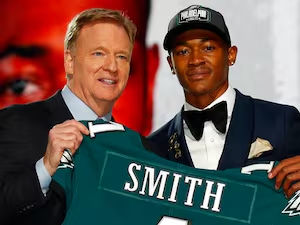
Tom Brady warns Caleb Williams about upgrading his game for his second season with the Bears
The transition from college football to the NFL is a daunting one for any quarterback, especially for a highly-touted prospect like Caleb Williams. After a sensational college career at USC, Williams was selected by the Chicago Bears in the first round of the 2024 NFL Draft, expected to be the cornerstone of the franchise’s future. His rookie season will be closely scrutinized, with fans, analysts, and pundits all eagerly watching his every move.
However, as much as the excitement of a young quarterback’s first year in the league can generate hope for a franchise, it’s clear that the transition to the NFL isn’t a walk in the park. This is where one of the greatest quarterbacks of all time, Tom Brady, has some advice for Williams. Brady, who retired in 2023 after winning seven Super Bowls and establishing himself as the NFL’s GOAT (Greatest of All Time), is no stranger to adapting his game to meet the ever-changing demands of the NFL. As Williams prepares for his second season with the Bears, Brady has offered a candid warning: If Williams hopes to elevate his game and fulfill his potential in the NFL, he will need to make significant upgrades, particularly heading into the pivotal second year of his career.
The Weight of Expectations
When a quarterback enters the NFL with as much hype as Caleb Williams, the expectations are monumental. In the case of Williams, this was amplified by his stellar performance in college. He won the prestigious Heisman Trophy in 2023, and many considered him the most pro-ready quarterback prospect since Andrew Luck. The Bears, coming off a disappointing 2023 season, hoped Williams could transform their offense and lead them back into contention.
However, despite all the optimism surrounding his selection, Brady’s message is clear: expectations for success are not just set by outside sources but also by the player himself. The first year in the NFL is often about survival—learning how to manage the speed of the game, adjusting to new schemes, and handling pressure from all sides. Williams, like every rookie quarterback, will face a steep learning curve, and Brady’s advice stresses the importance of understanding that the initial success or struggles in a quarterback’s first season don’t determine their future. It’s the second year that often marks the beginning of true development.
Tom Brady’s Legendary Second Year
Brady, of course, didn’t take the traditional route to NFL stardom. His rookie season in 2000 with the New England Patriots was a quiet one, where he served as a backup to Drew Bledsoe. It wasn’t until 2001 that he took over as the starter following an injury to Bledsoe and subsequently led the Patriots to a Super Bowl victory in just his second year. His story is one of overcoming doubt, learning to evolve, and making crucial adjustments.
Brady’s second-year leap was a combination of refining his mechanics, gaining confidence in his decision-making, and understanding how to process NFL defenses at a high level. This trajectory is one that many quarterbacks follow, and Brady sees parallels in Williams’ path. As good as Williams is, Brady knows he’ll have to put in significant work during his second offseason to unlock his true potential.
The Learning Curve: Developing the Fundamentals
One of the first things Brady emphasizes in his advice to Williams is the importance of mastering the fundamentals. While college football offenses are increasingly complex, the NFL is a different animal altogether. Williams’ first year will be a lesson in understanding how defenses adjust, how schemes evolve week to week, and how to counteract the various defensive strategies designed to exploit any weaknesses. In particular, Williams will face defensive coordinators who have years of experience breaking down quarterbacks and making life difficult for young signal-callers.
Tom Brady’s journey to success was built on a foundation of fundamentals. His ability to make quick, decisive throws, read defenses, and adjust to the tempo of the game was honed through countless hours of film study, practice, and attention to detail. Brady’s second year was all about tightening up the mechanics that would carry him through the peaks and valleys of his career.
“Caleb has all the tools, but now it’s about consistency,” Brady explains. “In the NFL, every game matters. You need to be able to read the defense quickly, make fast decisions, and be on top of your game every week. That’s the next step for Caleb—taking that raw talent and making it consistently great.”
Upgrading Physical Mechanics
While Williams is already an incredibly gifted athlete with a strong arm, Brady’s advice goes beyond just the mental aspect of the game. In order to upgrade his game for his second season, Williams will need to focus on improving his physical mechanics as well. This includes his footwork, his release, and his accuracy under pressure.
During Brady’s career, he was known for his precision throwing, even under intense pressure. His footwork was often regarded as one of the keys to his success. His ability to quickly reset his feet, maintain balance, and throw accurately on the move helped him thrive in a league that demands precision.
Williams, like any young quarterback, may rely too much on his raw talent and arm strength. Brady warns that while a big arm can win games, the key to long-term success in the NFL is mastering the subtleties of footwork, timing, and understanding the movement of his receivers.
“Caleb’s got the tools to be an elite quarterback, but the best quarterbacks can throw accurately to every part of the field, regardless of the situation,” says Brady. “Footwork will be huge for him moving forward. The small things like staying balanced, understanding the rhythm of your dropbacks, and resetting your feet when you’re under pressure—those are things that will make a difference in the long run.”
Mental Resilience: Handling the Pressure
Perhaps the most important piece of advice Brady gives Williams is related to the mental resilience required to succeed as an NFL quarterback. The pressure on young quarterbacks is immense, and the expectations can feel crushing, especially when things don’t go as planned. Williams will face situations where his team is trailing, where he’s under duress from defensive linemen, or when the media and fans are quick to judge his every move.
Brady knows firsthand what it’s like to face adversity, particularly early in a career. After starting his second year with New England, Brady was thrust into high-pressure situations, especially in the postseason. He responded with composure and poise, earning him the moniker of being “clutch.”
“Things are going to go wrong, and that’s part of the NFL,” Brady says. “You’ve got to learn how to stay calm under pressure. Your second year is where you really start to figure that out. You start to build a sense of trust in yourself and your preparation.”
Brady’s advice on mental resilience underscores the importance of perseverance. As a young quarterback, Williams will face challenges, including mistakes and setbacks. How he reacts to those moments will define his future success. Brady emphasizes the need for patience and consistency, understanding that every mistake is an opportunity to grow.
The Role of Coaching: A Strong Partnership
Another critical aspect of upgrading his game, according to Brady, is developing a strong partnership with his coaching staff. The second year is a time when quarterbacks must take more ownership of the offense. While a first-year player may rely more on their coaches to dictate plays and strategies, Williams will need to take on a more active role in collaborating with his offensive coordinators and position coaches.
“Caleb needs to become a master of his offense,” Brady advises. “It’s not just about the plays called in the huddle, it’s about how he adapts and controls the flow of the game. The best quarterbacks know how to communicate with their coaches and make sure that what they’re doing on the field makes sense based on what they see in the defense.”
This kind of collaboration between quarterback and coach can lead to breakthroughs, but it also requires a quarterback to truly understand the intricacies of the offensive scheme. Brady’s long-standing success was in part due to his ability to adjust on the fly and make smart decisions with the ball, something he learned through years of working closely with Bill Belichick and his offensive staff.
The Road Ahead for Caleb Williams
As Williams prepares for his second season with the Bears, there’s no doubt that he’s got the talent to succeed in the NFL. But as Tom Brady warns, it’s the upgrades made in the offseason and the commitment to refinement that will separate the good from the great. For Williams, the task ahead is monumental. The pressure of carrying the Bears’ future rests on his shoulders, but with the right mindset, commitment to improvement, and unwavering confidence, he can follow in the footsteps of some of the greatest quarterbacks to ever play the game.
In his second season, Caleb Williams will need to take the next step—one that many quarterbacks before him have taken—by upgrading his game in all aspects. As Brady’s advice suggests, it’s not just about physical talent; it’s about mastering the details, staying resilient under pressure, and never losing sight of the bigger picture. If Williams can do that, he may well be on the path to becoming the quarterback that Chicago has longed for.





